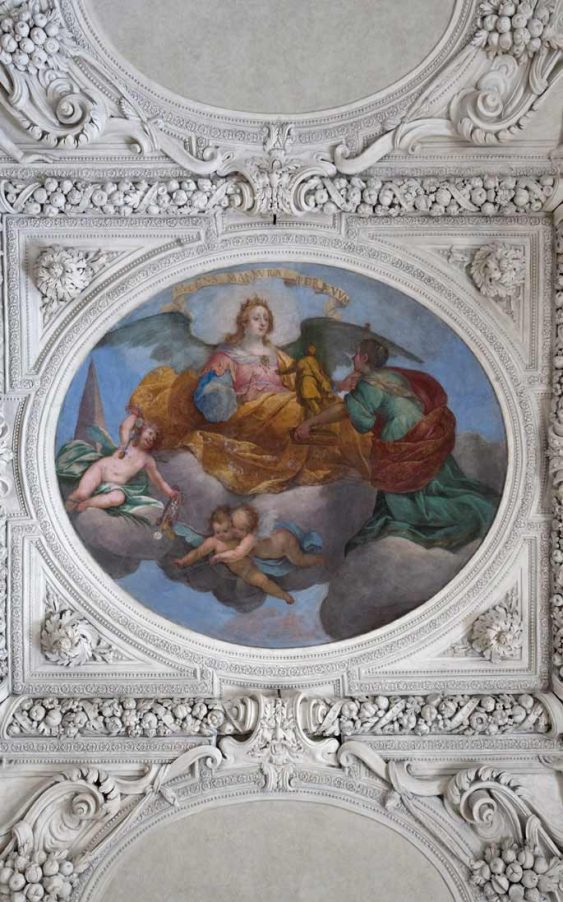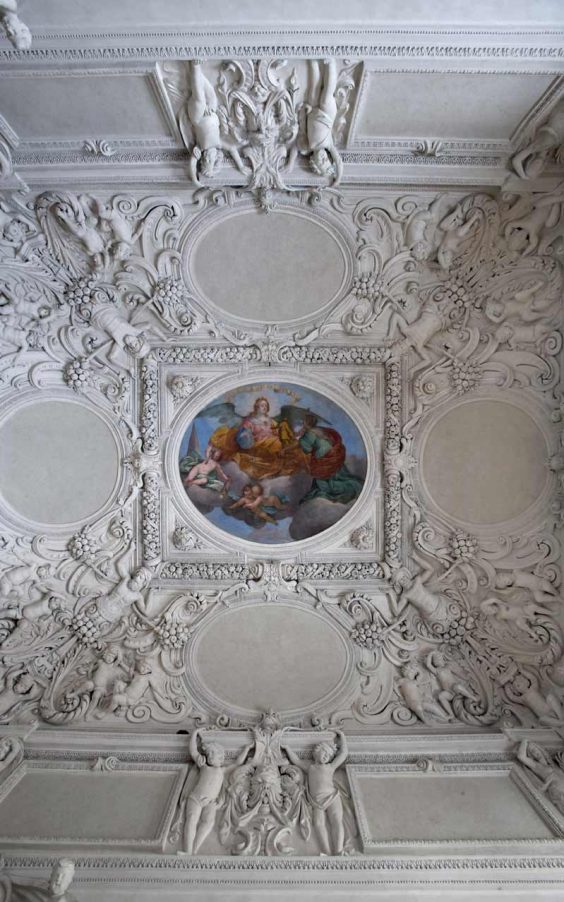Gian Paolo Recchi and his team started painting the frescos in this room in 1665, from subjects provided by Filippo d’Aglié, who continued to run the Valentino even after the death of Madama Reale in 1663. In 1665, once the foreman Baguto had put up the scaffolding, Recchi received an advance payment of 300 lire for the paintings ‘to be done in the celebrations and Pomps Room at the Valentino’ and so appointed a plasterer to prepare the walls for painting.
It is no coincidence this room was decorated after the death of Maria Cristina because the large central circular panel in the ceiling shows Her Magnificence the Sovreign, to whom the arts and sciences give eternal fame. As the writing explains: “LUCE MANSURA PER AEVUM” which crowns, the feminine figure, victoriously winged and holding the sceptre which commands, triumphantly in the centre of the panel she is being offered the statue of a young man, which is the symbol of sculpture but which also represents sovreign Genius. The presence in the background of a pyramid reconfirms their belief in the eternity of fame, as Cesare Ripa explains in his Iconografia: It is a worthy attribute to the splendour of princes who build magnificent and sumptuous palaces as eternal wit-nesses to their glory”.
D’Aglié reconfirms this in his “Delizie” where he praises Maria Cristina’s sovreign Genius: “Madama Reale belonging to an illustrions family reflects her divine genius through her ideas, as if in a mirror. This Genius guides, teaches and advises on every aspect of moral and human life, and illuminates the higher intellects with its action. The Genius symbolises the guardian. Madama Reale was the state’s Regent as her son’s tutor. The Elei adored their Genius, Sosiopoli whose name means “Saviour of the People”. Madame Reale is praised as the Saviour of the state, especially during the Civil wars. Ceremonies were dedicated to the Genius of Augustus”.
It is exactly this sentence which explains the link between the decoration of the circular panel and the other frescos which decorate the vault and the rectangular plaques in the freize at the end of the walls. The only plaque which is still intact enough for us to understand is on the west side and shows a public feast in space prepared deliberately for the purpose in front of Palazzo Madama. This facade is dominated by a central ‘Serliana’ window and framed by towers and is comparable to that depicted in the fresco in the salon of Valentino. This fresco shows Carlo VIII’s entry into Turin. The white stucco-work is dominant in this room too, as it moves uninhibited around the room and oblivious to any architectural obstacles, over the swollen cornice, it almost becomes a garland wrapped up in fruit which frames the central space of the ceiling. The telamoni and putti which join the oval panels and almost completely cover the ceiling, are accompanied by groups of putti supporting the palm leaf the symbol of triumph, in the border of the walls. the different style of stucco works documents the employment of another craftsman in this work: in 1664, payments were registered as “doubles 100 … to the plasterer Corbellino for the stucco-work in the Festivals Room including to the doors he did at the Valentino”. This reference was to Giovanni Luca Corbellino, the same craftsman who had modelled the stucco-work in the columned room.


